中美貿易戰下的台灣戰略地位與策略
accessed Sep 7, 2020
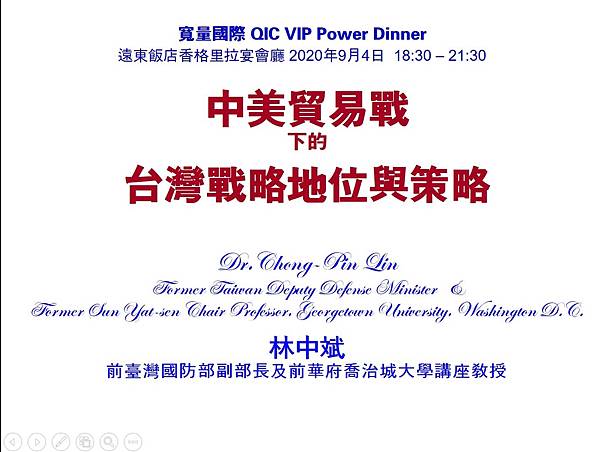
https://drive.google.com/file/d/1354ZAxmu5mapq3Orzu-zoNfDiWvU9N9E/view
中美貿易戰下的台灣戰略地位與策略
accessed Sep 7, 2020

https://drive.google.com/file/d/1354ZAxmu5mapq3Orzu-zoNfDiWvU9N9E/view
永豐金控 主題演講
accessed Aug 27, 2020


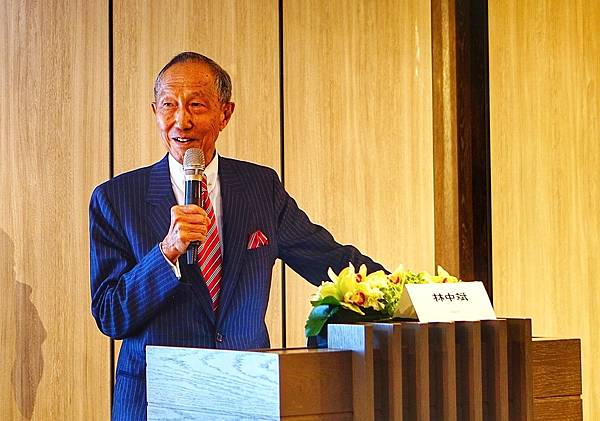

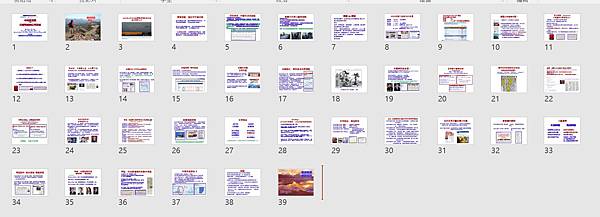

Five hundred had registered to attend, the organizer told me before I entered a perhaps 99% packed hall. Thanks to my invited friends who came to boost my morale. Eight days of preparation kept me busy up to my last revision at 5-6 am this morning. Courtesy James Chen and 張譯丰 for the great photos.
Beijing's Grand Strategy: Implications on Belt Road Initiative and Taiwan Security
accessed Nov 18, 2019
“Beijing's Grand Strategy: Implications on Belt Road Initiative and Taiwan Security”
Keynote Speech, 2019 International Conference on PLA Modernization November 14, 2019
■Opening Remarks
From 1949 to 1979, China waged six wars across its borders. From 1979 to 2019, the number of wars it waged beyond its borders is zero.
Why?
■If you say that the world became more peaceful since 1979, and that is why. It is not so!
■During the same forty years since 1979, the U.S. launched seven wars abroad and occupied two countries. Meanwhile, the former Soviet Union and Russia, fought five wars abroad and occupied three countries. Yet, on both scores, China’s is zero.
Why then?
■During the first 30 years, as China was poor, backward and struggling, it was prone to war-fighting. In the following 40 years, as China began to rise, it has become war-aversive.
■“War is an instrument of ill-omen, use it only when left with no choice.” So said Laozi, a Chinese sage in the sixth century before Christ. As China gradually becomes prosperous, war as a foreign policy option falls to the last priority.
■In strong contrast to the West, Sun Zi -- the most influential Chinese strategist over more than two thousand years -- said, “ Winning without fighting is the optimal strategy.” In other words, in war or any form of contest, violence is best to be avoided. The underlying spirit is to seek the approach that encounters the least resistance. As a result, to achieve victory with minimum casualties and bloodshed is the most desirable.
■Whereas, Karl von Clausewitz, the equivalent of Sunzi in the West, said “War is violence pushed to its utmost bounds.” In other words, in war, violence is maximized and unavoidable. Crushing the enemy with overwhelming force is the best, regardless of casualties and bloodshed.
■Deeply rooted in Chinese strategic tradition, Beijing’s grand strategy in the 21st century is “dominating Europe, Asia and Africa or Eurasiafrica without war”.
With what then?
■With extra-military instruments such as economy, diplomacy, and culture on the front, but supported by China’s rapidly advancing military capabilities as the backbone. The idea, seemingly self-contradictory, is reminiscent of Teddy Roosevelt’s adage, “Speak softly and carry a big stick, you will go far.”
■“Extra-military” differs from “non-military” in that it transcends, but not excludes, the military.
■The purpose is to minimize resistance for Beijing to expand its geopolitical influence.
■The decision for Beijing to go west first – over the World Island and Africa, --instead of east -– over the Pacific, -- also reflects choosing the route of the least resistance to avoid immediate confrontation with the U.S. and Japan.
■In this context, Beijing’s Belt Road Initiative (BRI) visibly manifests its unsaid grand strategy.
林中斌倫敦政經學院演講"一帶一路"
accessed Nov 12, 2019
林中斌倫敦政經學院演講"一帶一路"2019年2月23日
這是今年2月在倫敦演講的錄影。在下的部分是13:46~23:58。之後尚有問答部分(36:47~39:36;50:57~51:47;56:50~57:56;1:03:45~1:09:02)。
敬請賜教。
林中斌 2019.11.12
This is the February 23, 2019 conference/debate on China's Belt Road Initiative at London School of Economics. My presentation comes in at 13:46 and ends at 23:58.During the Q&A, my contributions come in four additional segments.(36:47~39:36;50:57~51:47;56:50~57:56;1:03:45~1:09:02)
Chong-Pin Lin
影片連結:https://drive.google.com/file/d/1CFJilBO2ZGaVeX6rnhmb6OttLK0B8ZzI/view
國際禮儀:淺見初探 (一)
accessed Oct 21, 2019

國際禮儀:淺見初探(一)─行為禁忌
演講時間:2019/8/20(二) 14:00~17:00
主辦單位:中華無盡燈文化學會
影片連結: https://www.facebook.com/chongpin.lin/videos/2731295953568470/
國際禮儀:淺見初探 (二)
accessed Oct 21, 2019

國際禮儀:淺見初探(二)─餐桌禮儀
演講時間:2019/8/20(二) 14:00~17:00
主辦單位:中華無盡燈文化學會
影片連結: https://www.facebook.com/chongpin.lin/videos/2731579310206801/
國際禮儀:淺見初探 (三)
accessed Oct 21, 2019

國際禮儀:淺見初探(三)─西裝穿著
演講時間:2019/8/20(二) 14:00~17:00
主辦單位:中華無盡燈文化學會
影片連結: https://www.facebook.com/chongpin.lin/videos/2731406213557444/
國際禮儀 鞋襪:玄黑、腿肚長
accessed Sep 7, 2019



林中斌「台灣的穩定:前景探討」
accessed March 25, 2019
這是在下2019年3月14日應在台北的某跨國企業邀請所做的演講。他們關切在台灣投資所將面臨的兩岸軍事衝突的風險。
This is my talk invited by a multinational corporation which is concerned of the risk of their potential investment in the area regarding military conflict across the Taiwan Straits.
I am sharing the contents with those who have similar concerns without revealing the name of my host.
跨國企業名稱隱去。演講內容分享。
敬請賜教。
林中斌 2019.3.17
Chong-Pin Lin March 17, 2019
倫敦政經學院演講
accessed March 11, 2019
在下於倫敦政經學院演講的場景、及內容。敬請賜教。
Dominating Eurasiafrica without War:
Beijing’s Grand Strategy behind Its Belt Road Initiative
Chong-Pin Lin
February 23, 2019
(A debate on the BRI: China’s debt-trap diplomacy or win-win cooperation? LSESU China Development Forum 2019
Embracing New Dynamics)
From 1949 to 1979, China waged six wars across its borders. From 1979 to 2019, the number of wars it waged beyond its borders is zero.
Why?
During the first 30 years, as China was poor, backward and struggling, it was prone to war-fighting. In the following 40 years, as China began to rise, it has become war-aversive.
“War is an instrument of ill-omen, use it only when left with no choice.” So said Laozi, a Chinese sage in the sixth century before Christ. As China gradually becomes prosperous, war as a foreign policy option falls to the last priority.
In strong contrast to the West, Sun Zi -- the most influential Chinese strategist over more than two thousand years -- said, “ Winning without fighting is the optimal strategy.” In other words, in war or any form of contest, violence is best to be avoided. The underlying spirit is to seek the approach that encounters the least resistance. As a result, to achieve victory with minimum casualties and bloodshed is the most desirable.
Whereas, Karl von Clausewitz, the equivalent of Sunzi in the West, said “War is violence pushed to its utmost bounds.” In other words, in war, violence is maximized and unavoidable. Crushing the enemy with overwhelming force is the best, regardless of casualties and bloodshed.
Deeply rooted in Chinese strategic tradition, Beijing’s grand strategy in the 21st century is “dominating Europe, Asia and Africa or Eurasiafrica without war”.
With what then?
With extra-military instruments such as economy, diplomacy, and culture on the front, but supported by China’s rapidly advancing military capabilities as the backbone. The idea, seemingly self-contradictory, is reminiscent of Teddy Roosevelt’s adage, “Speak softly and carry a big stick, you will go far.”
“Extra-military” differs from “non-military” in that it transcends, but not excludes, the military.
The purpose is to minimize resistance for Beijing to expand its geopolitical influence.
The decision for Beijing to go west first – over the World Island and Africa, --instead of east -– over the Pacific, -- also reflects choosing the route of the least resistance to avoid immediate confrontation with the U.S. and Japan.
In this context, Beijing’s Belt Road Initiative (BRI) visibly manifests its unsaid grand strategy.
There is no denying that the BRI has encountered resistance. In Southeast Asia, by late 2018, China had only 12 large investment projects left, down from 33 a year earlier. In Malaysia, for example, the re-elected Prime Minister Mahathir Mohamad has recently canceled the “East Coast Rail Link” project with China for fear of sinking into bankruptcy by incurring heavy debt.
However, in Europe and the Middle East, increasing number of harbors, airports, railway stations are now run and even owned by China in countries far from bordering on bankruptcy.
Israel’s largest international seaport Haifa as well as its second largest, Ashdod, will be owned by China for 25 years starting in 2021 as a result of China’s work on port expansions for Haifa and Ashdod that started in 2015. Israel’s average GDP growth over the last five years was more than three percent (3.52%) higher than that of the U.S. at slightly over two percent (2.12%).
It would be quite contrived to term the case above a debt-trap deal. A win-win cooperation looks more like it.
Greece was bankrupt in 2008. Its GDP grew at minus 9.1% in 2011. China arrived in 2008 with some $9 billion investment on infrastructure constructions. In 2014, Greek GDP grew 0.7%, first time above zero in six years. In 2005, Athens let China manage its largest seaport Piraeus. In 2016, China’s seafaring company COSCO bought Piraeus for 35 years. In 2017, Greece’s GDP grew positively at 1.4% up from minus 0.2% in 2016. And on 26 August 2017, Piraeus was rated by New York Times the busiest seaport in Europe. From 2010 to 2018, Piraeus shot up the rankings of the world’s busiest container port from the 93rd to 38th.
Is Greece a victim of China’s debt-trap diplomacy? Hardly.
In 2017, COSCO bought Zeebrugge port, the second largest in the Netherlands. In the same year, COSCO bought Valencia port, the largest in Spain.
Are the Netherlands and Spain yet other victims of China’s debt-trap diplomacy? Apparently not.
As China applies the BRI to the developed countries, the outcomes resemble more win-win cooperation than debt-trap diplomacy. On the other hand, as China’s BRI applied to the developing world, sad cases resembling debt-trap diplomacy have occurred.
Are the problematic cases the intended consequences of Beijing’s strategic design or the outcomes of Beijing’s shortsighted conception and faulty implementations? An unequivocal judgement one way or the other is difficult to reach without peeping into the black box of Zhongnanhai’s decision-making apparatus which obviously is infeasible.
If the BRI is Beijing’s conceived route to realize its “China Dream”, win-win cooperation rather than debt-trap diplomacy is the pragmatic policy option to pursue. It is because win-win cooperation reduces resistance and enhances the chances of success while debt-trap diplomacy only self-obstructs and pushes its China Dream ever further away from realization.
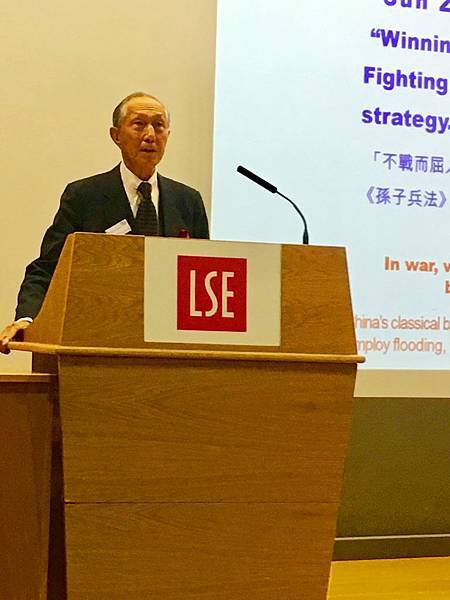
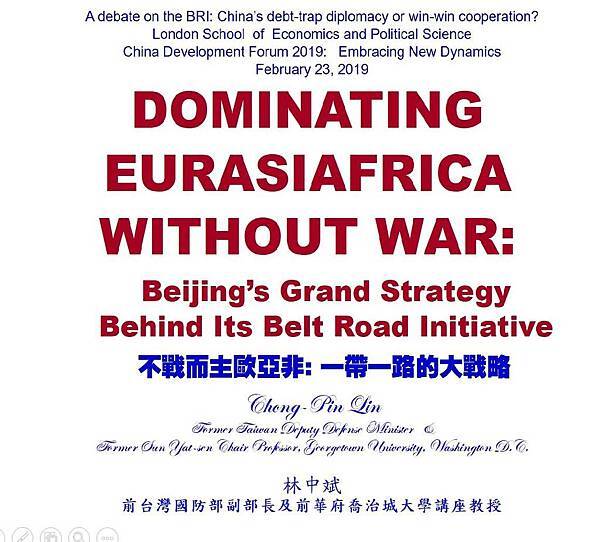
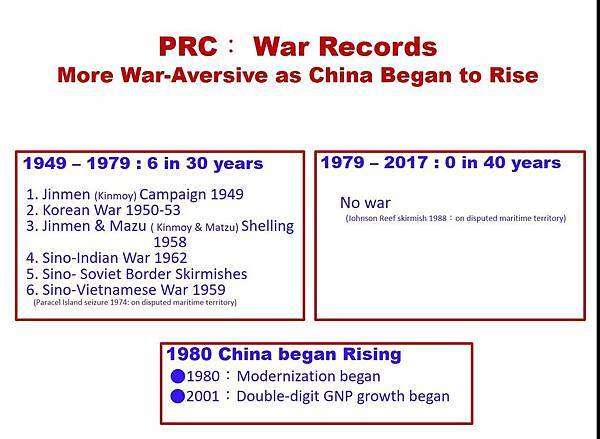
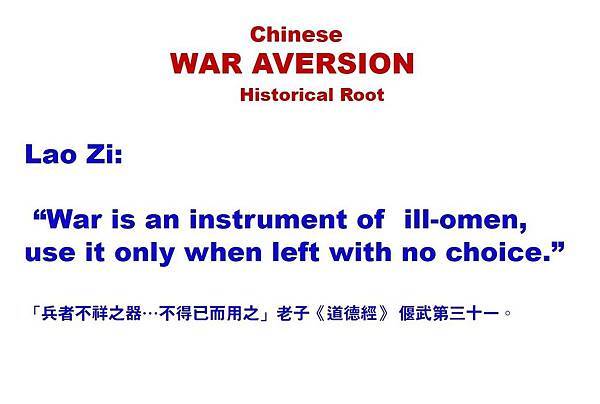
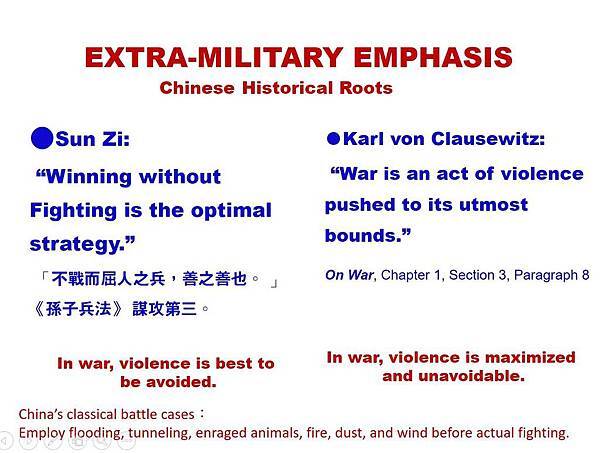

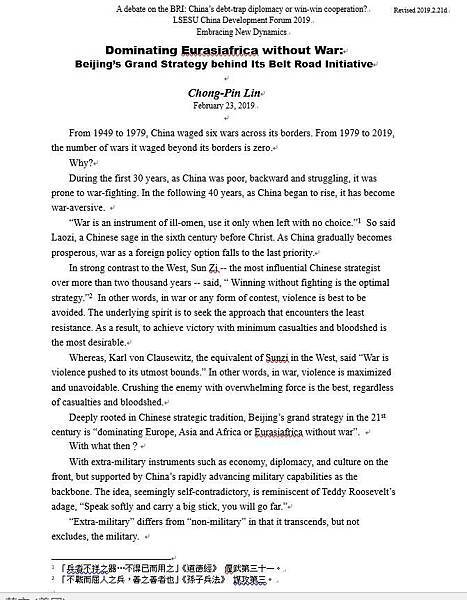

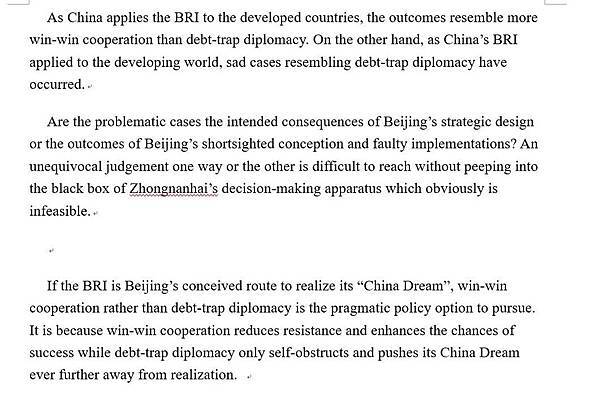
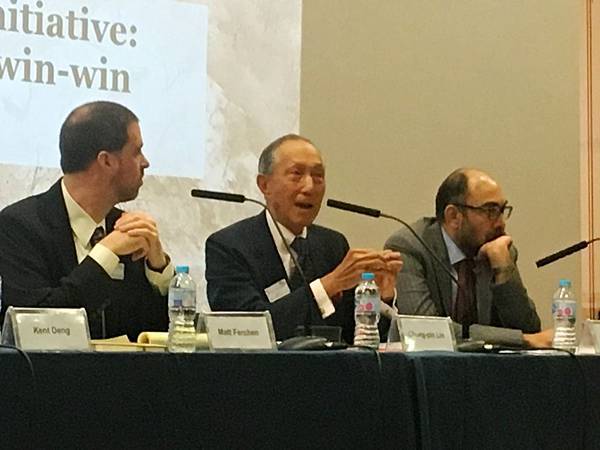
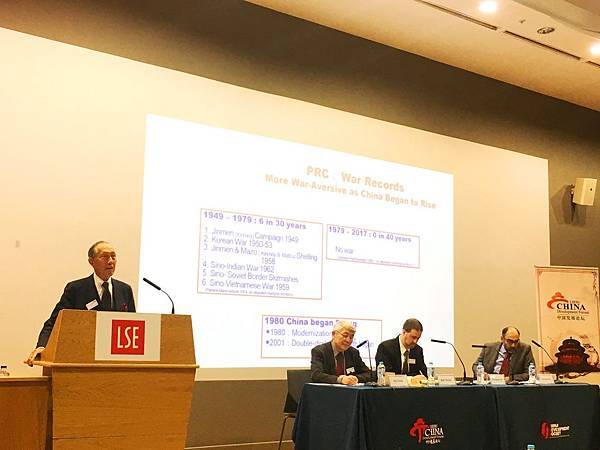
林中斌,〈台灣: 大愛與理盲並存的社會〉
《聯合報》 2013年4月15
accessed Aug 16, 2018
日
感人至深!!
*這或者是撲向臺灣的颱風連續幾年都臨時轉彎的原因之一。
*臺灣亂象充徹的媒體上看不見的社會另一面。
*一定要有淤泥才會長出蓮花嗎?
林中斌 2018.8.16


嬌小的身影,柔軟的音調。台上拿麥克風的女孩,指著銀幕上她相機所捕捉的「草根台灣臉譜」皺紋滿面的阿公阿嬤,娓娓陳述台灣低層社會賺人熱淚的獨擊報導。
一百零三歲阿美族人瑞婆婆,正在細心手編要送人的多彩竹藍。她告訴沈芯菱自己快樂秘訣:要不斷把快樂帶給別人!
連續種玉米得冠軍的阿姨,在驕陽下戴著斗笠燦爛的笑著。她送給鞠躬不已的鄰居禮物竟是一包包玉米種子。周圍有優良的玉米花粉,風吹蜜蜂飛,阿姨的玉米才會不斷得冠軍。
出身雲林縣貧苦家庭,半工半讀,清華大學畢業,現攻台大研究所。廿三歲的沈芯菱,從十一歲起開始她獨特的愛心事業 ─ 幫滯銷果農網銷、助弱勢學生教育等 ─ 已是國際知名的慈善家。
三月廿四日,我很榮幸為「台灣創格論壇」作主題演講。但是我與人分享的,遠不如我從三位隨後登台青年身上獲益的多。除了沈芯菱之外,還有卅歲的「倒立先生黃明正」,和「名人開講」(TEDXTaipei)台灣創辦人卅出頭的許毓仁。他們共同之處有四:
一、出身低微。不是攤販、便是貧農。二、有夢想、有毅力。他們所做,開始時倍受嘲諷,但堅持不輟,成果斐然。三、有邏輯、無贅字。講話理路清晰,無膨風,沒廢話。四、大愛。沈芯菱感人事蹟不說,黃明正用倒立激勵癱瘓兒童追求他飛行的夢想,用倒立引人注意環境的破壞及地震災民的困難。許毓仁以影像紀錄不同人士「十八分鐘自述」為社會注入關懷與溫馨。
這四項中最大的力量是愛心。從捷運上讓座的青年,到澳洲洪水後立刻出現救災的當地慈濟人(市長打了八通電話給政府,仍沒人來),大愛已是台灣耀眼的光芒。
聽完他們三位的故事,我看到台灣的希望。但是愉悅的心情不久便被「核四」爭議覆蓋了。
國家面臨如此重大的公投議題,無論在媒體上,無論在政府文件上,無論在專家分析上,人民卻看不到一頁正面反面理由同時出現的比較表!在歐美,公投前,此種正反對照表早已滿天飛了。
在台灣,我們每次所能看到聽到的都是一方面的論點。單看單聽,都言之成理,而且振振有詞。
例如,擁核的會說:「法國百分之八十靠核能,從未發生意外。不建核四,核一核二更危險。」反核的會說:「近年政府運作失常,無法保證不會誤失,核災一旦發生無法挽回。」除上列說法之外,雙方各式理由還有更多。但是就是見不到一目了然囊括所有正反理由的全貌。
其實,對幾乎所有的爭議,除了總統選舉,台灣都看不到正反論述併陳的報紙版面,或雙方辯論的場合。為什麼?
淺見是: 理盲。我們社會在思緒智力上已愈趨退化了。對深度研究不耐,卻熱衷腦筋急轉彎。我們國際比賽獲冠軍的項目是:釀酒、製麵包、服裝設計、高爾夫球、中學樂隊等。哲學歷史的創見?科學的重大突破?多嗎?
所以,堂皇的國會裡討論嚴肅的安全議題,居然問國防部長「人魚線為何」!報紙頭版頭條竟然充斥綜藝新聞!
台灣的弱項是智慧淺碟化。台灣的強項是愛心海洋化,既深又廣。
台灣若長此以往,政治軍事恐將淪為配件,生活社會將升為主體。
未來,台灣強軍建國?甭想。也甭難過,因台灣將成小而美的社會。
林中斌曾任國防部副部長,現為退休國際關係和戰略教授。
Opening Remarks
CHINA’S ATYPICAL RISE
Dominating East Asia Without War
Chong-Pin Lin
Assurex Global Asia/Pacific Conference,
January 17, 2018, Mandarin Oriental Taipei
另類大國崛起:北京不戰而勝而主東亞
2018年1月17日 國際企業集團 Assurex Global
亞太年會 主題演講
開場白
Last month, the president of Sri Lanka handed over to China Hambandota, an important port with the potential of becoming a naval base, for $292 million U.S. dollars to the chagrin of India, Japan and the U.S..
Interestingly, he, when elected president in January 2015 had suspended the port project with China, which had been previously launched by his predecessor.
Why did he flip flop?
In June last year, the flagrantly anti-China prime minister of Japan, Shinzo Abe, indicated his willingness to cooperate with China on its Belt Road Initiative, which Abe had previously resisted doing.
Why did he shift his anti-China posture?
At the end of last August, Indian prime minister Narenda Modi suddenly ended the border standoff between Indian and Chinese troops in Daklom that had begun in June.
He then ordered Indian border troops to learn 50-60 Chinese sentences to avoid future misunderstanding between the two sides.
Five days later, he appointed a new defense minister in the morning, and then left for China, arriving in Xiamen late in the evening to attend the BRICKS summit, along with leaders from Russia, Brazil and South Africa, which was hosted by Chinese president Xi Jinping.
A month later, the new defense minister of India greeted the Chinese soldiers on the Sino-Indian border with a “Namaste”, which means “I bow to you”.
Why did Modi and his defense minister take these actions accommodating China?
COMMON DENOMINATOR
The common denominator of all three cases is China’s economic instrument employed to promote its regional influence.
●Sri Lanka, incapable of paying the mounting debt to China, succumbed to Beijing’s offer for the Hambandota Project .
●Japan’s Abe after US withdrew from the Trans-Pacific Partnership under President Donald Trump began to feel cooperating with China economically and
otherwise more attractive and even necessary.
● India’s Modi did not want to miss attending the BRICK summit hosted by China for its potentials of economic benefit to India.
This is only part of a bigger picture.
CONCLUSIONS
1. China’s grand strategy in the 21st century is dominating East Asia without war.
Aversion to war-fighting, rooted in history, is observed to reduce resistance to China’s rise .
2. China’s rapidly advancing military capabilities serve not at the front but as the backbone of its extra-military instruments.
3. China’s guideline for contending with neighbors is “struggle without breaking”.
4. China’s extra-military instruments include most prominently those of economy, but also of diplomacy, psychology, media, and characteristically culture – professional, popular, and even spiritual culture such as religion.
5. Religion as policy instrument, coming to the fore under Xi Jinping, aims to promote domestic stability, and to enhance Beijing’s international image.
6. Xi’s two-pronged Taiwan tactics, in the wake of the 19th Party Congress, are eing implemented with new vigor. The objective is to alter Taiwan’s public opinion in favor of cross-strait integration without war.
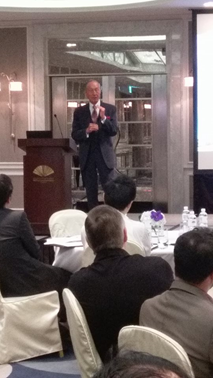
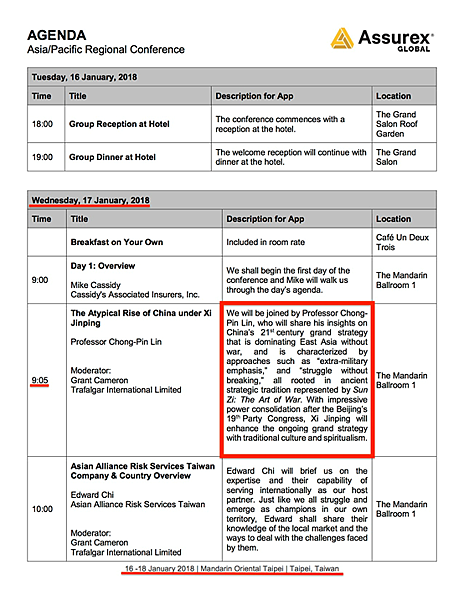
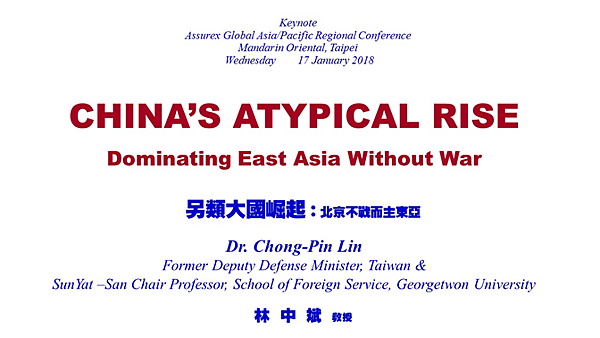

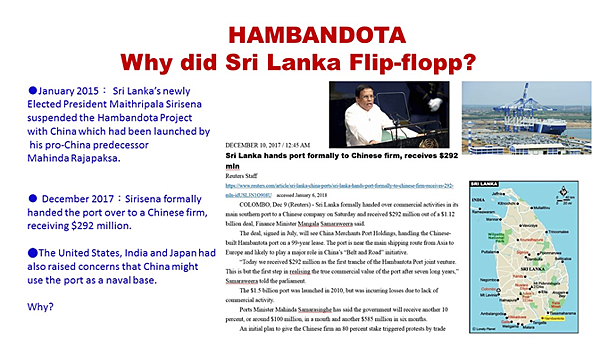
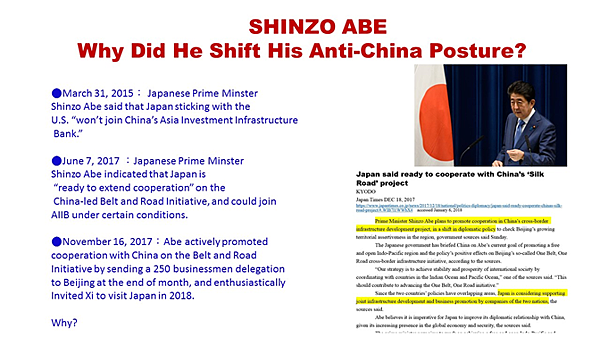
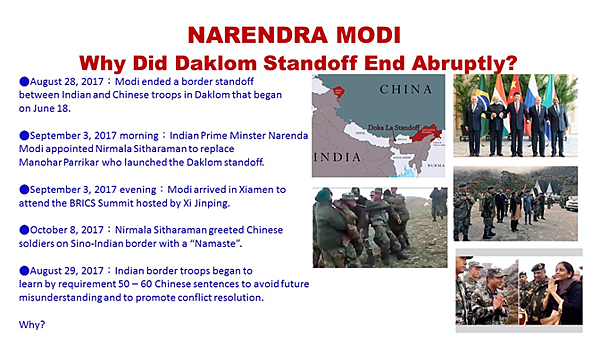
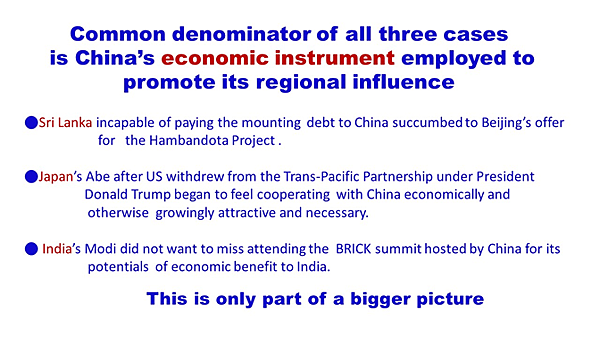
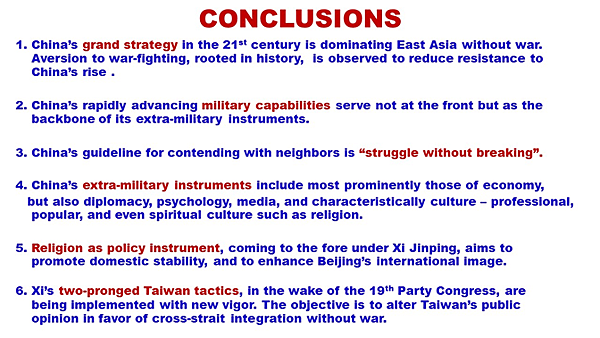
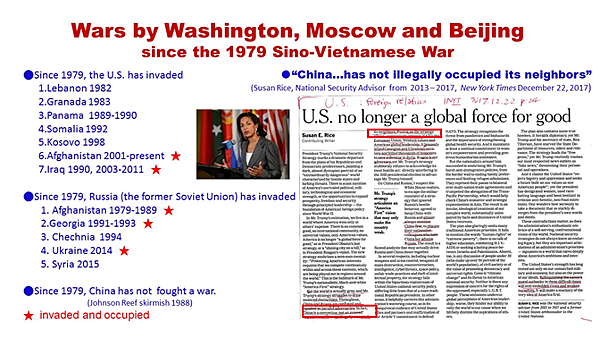
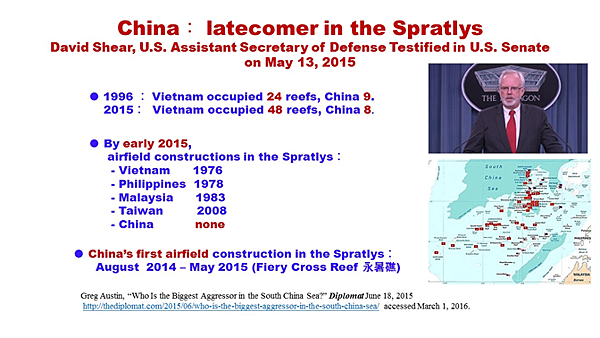
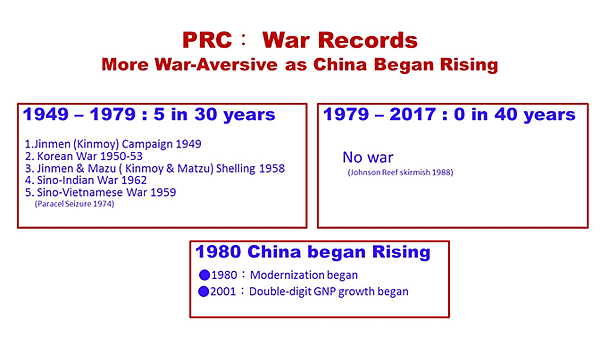
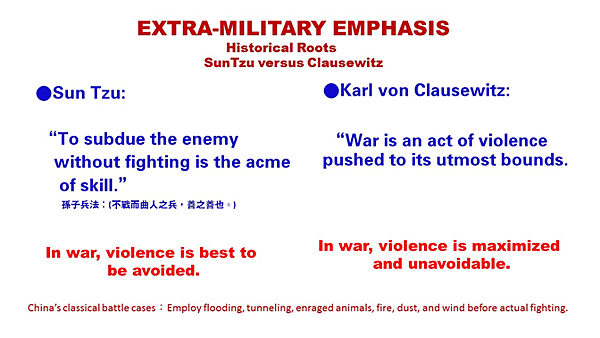
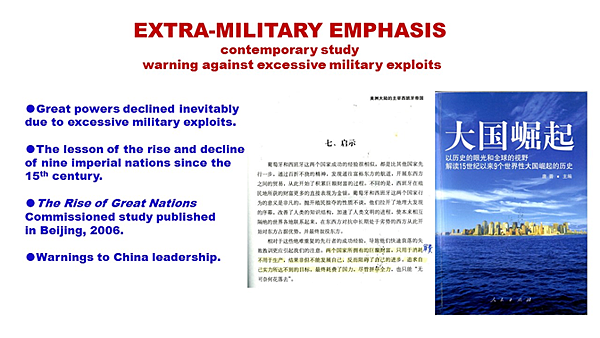
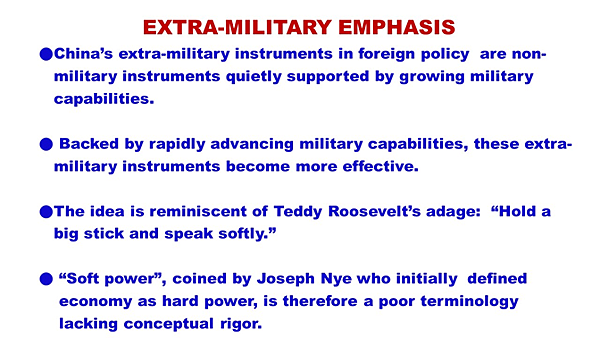
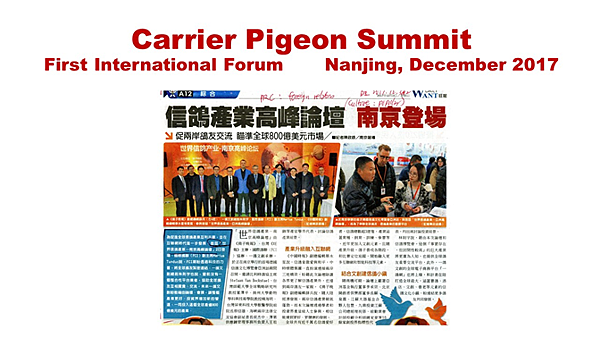
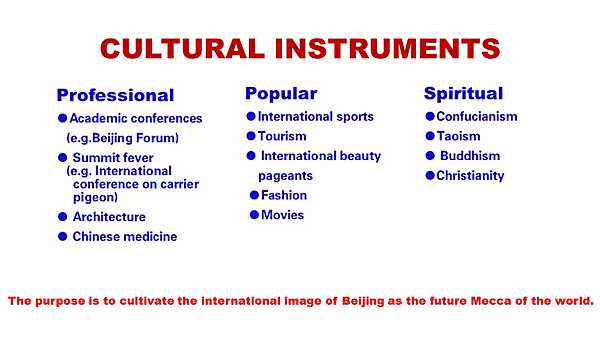
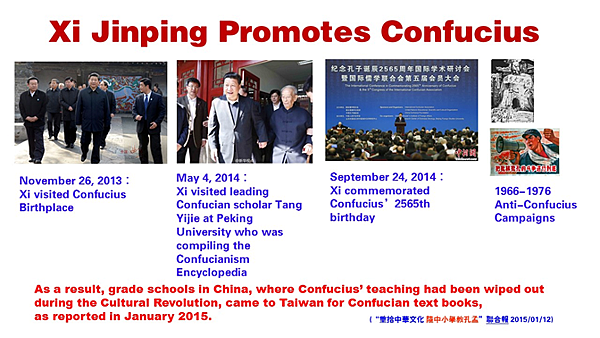
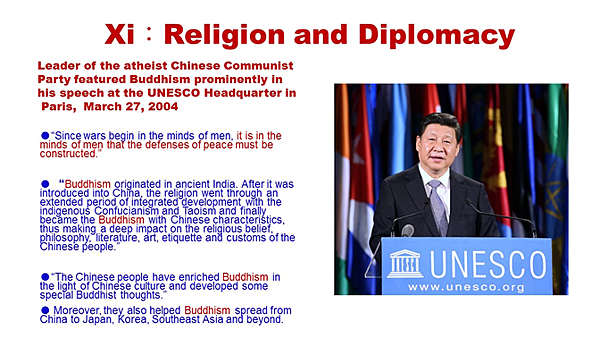
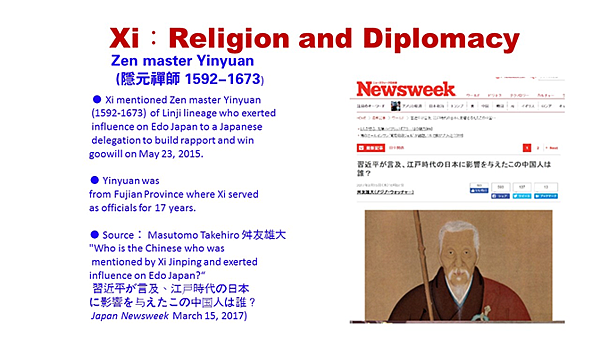
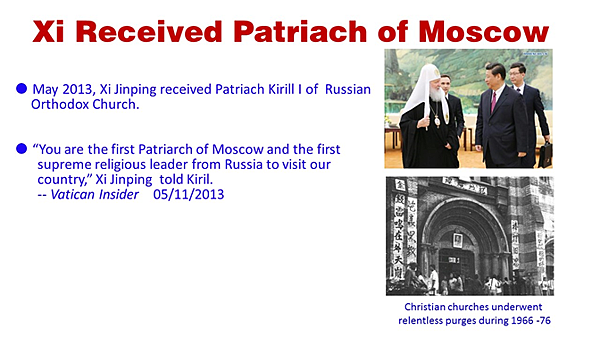
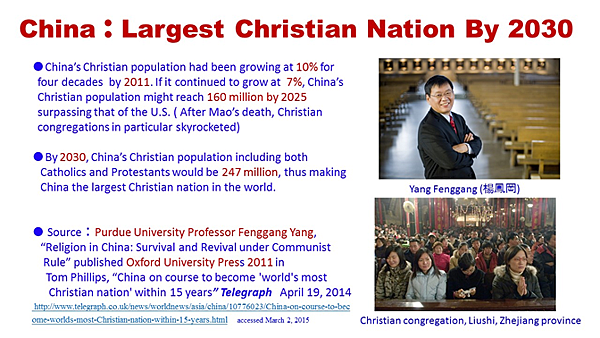

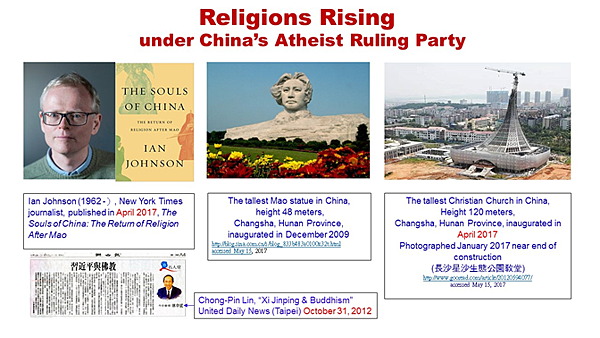
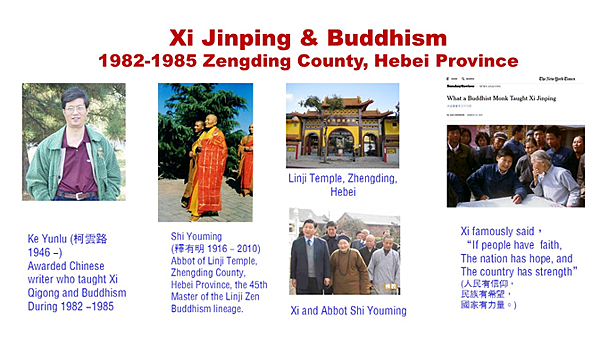
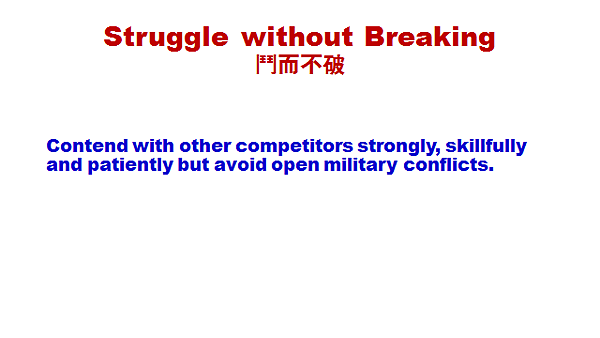
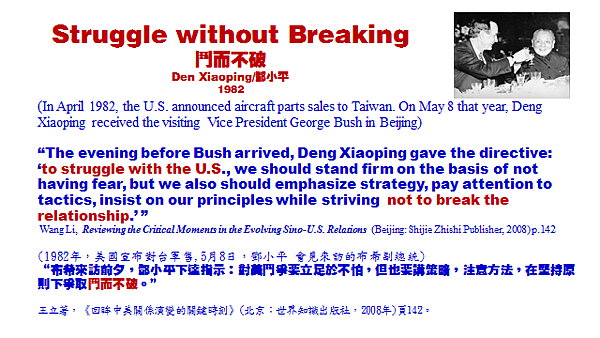
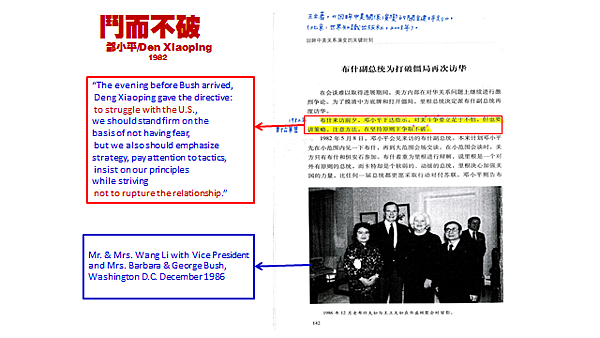
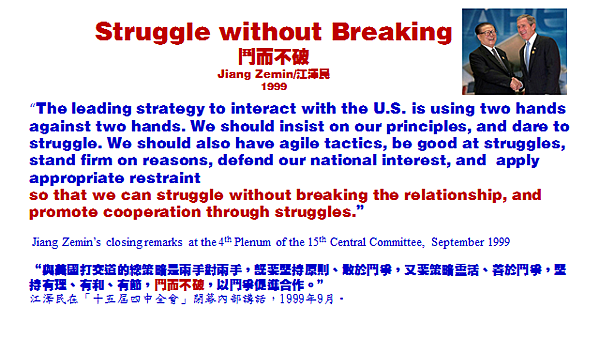
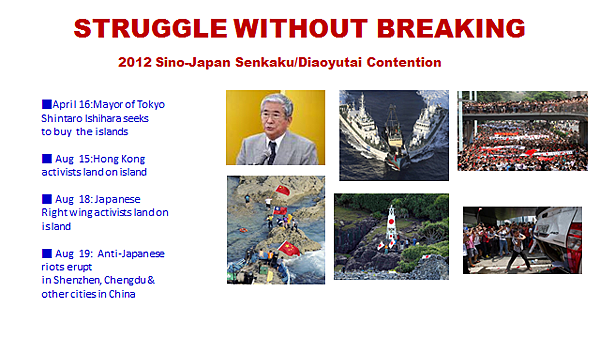
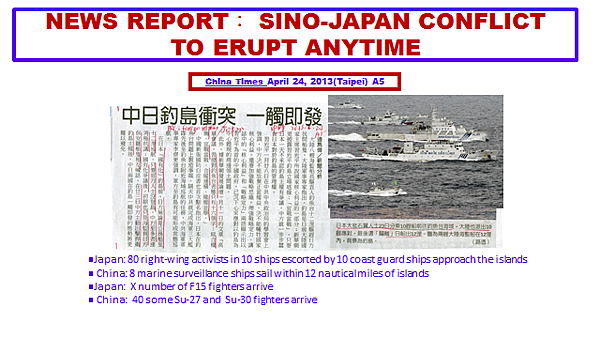
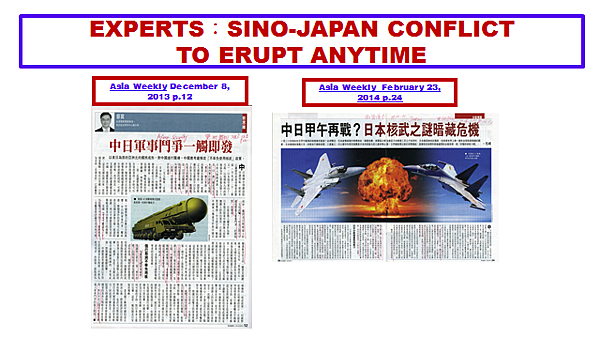
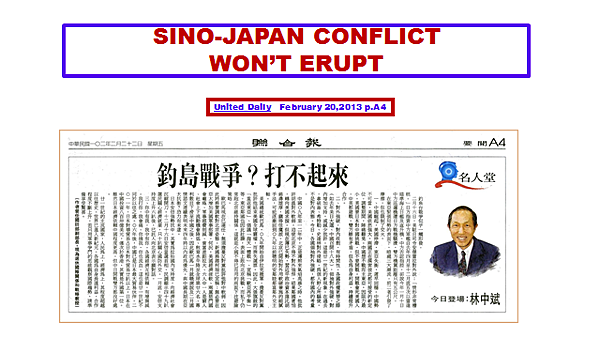
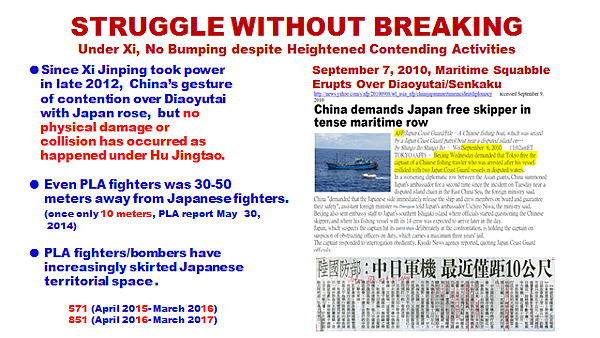
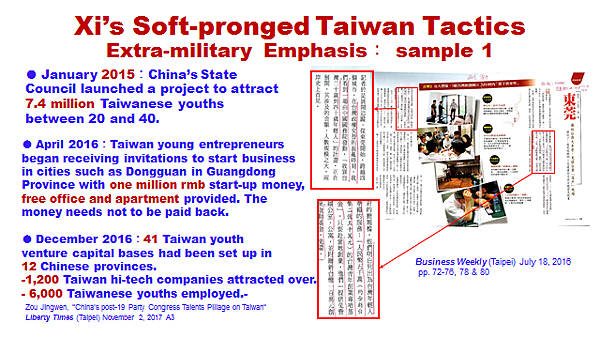
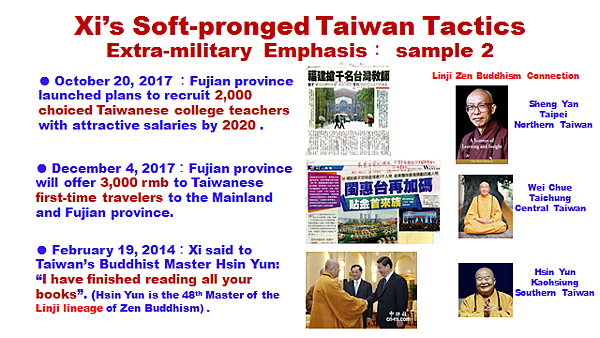
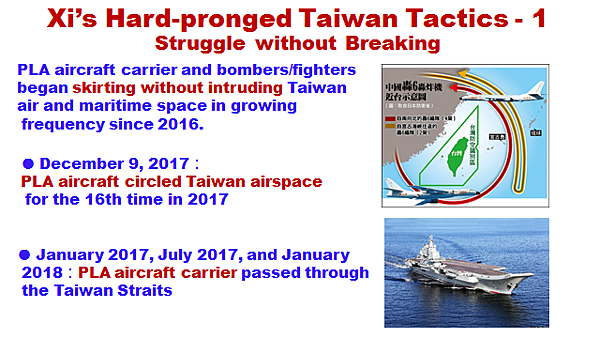
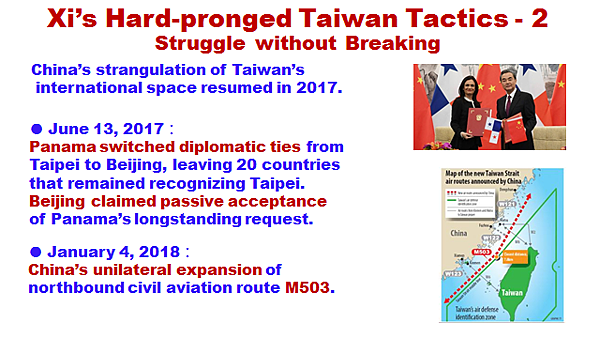
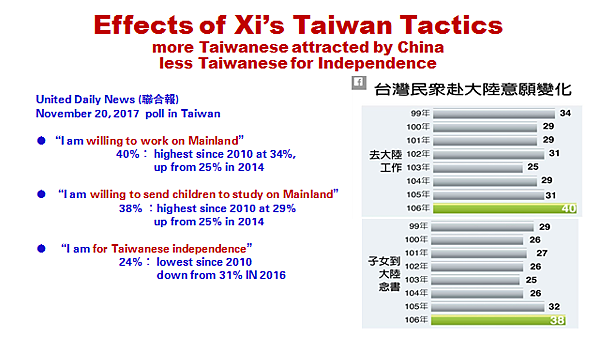

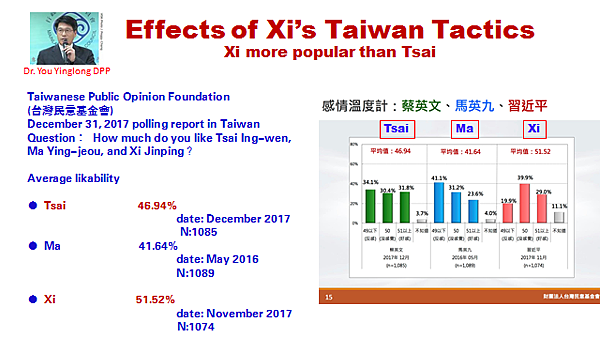
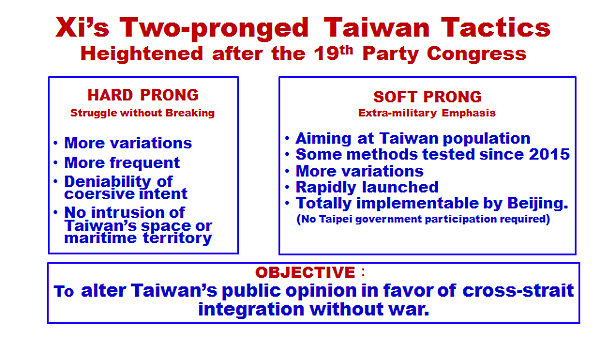
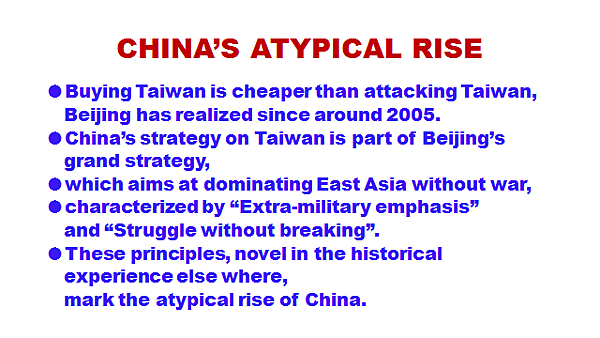
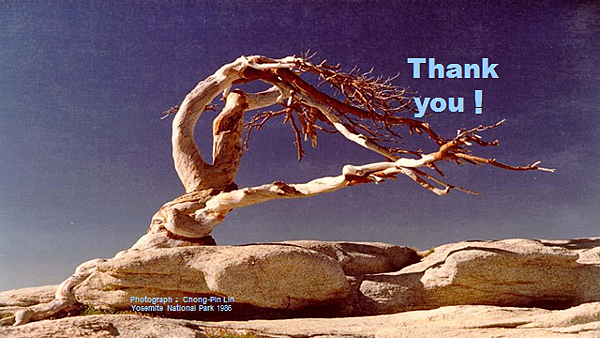
● 2017年8月23日《撥雲見日》新書發表會簡報敬請賜教。
林中斌 2017.8.22










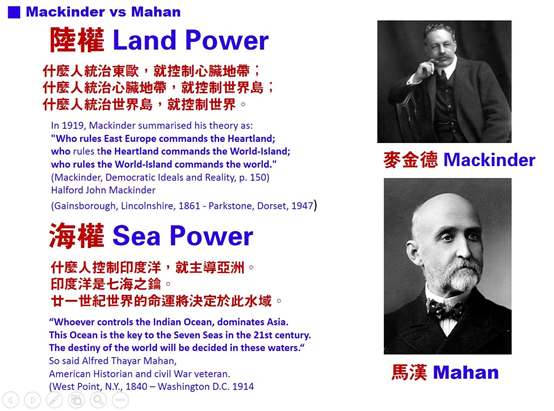




How to present your views convincingly without stepping on others' toes? Jack Ma did it.
● 請看馬雲如何陳述自己的觀點而不引人反感。值得學習。
林中斌 2017.1.22

南海仲裁後 高潮已過,戲演完了
2016年7月15日訪問 2016年7月18日稿 記者 Mr. J

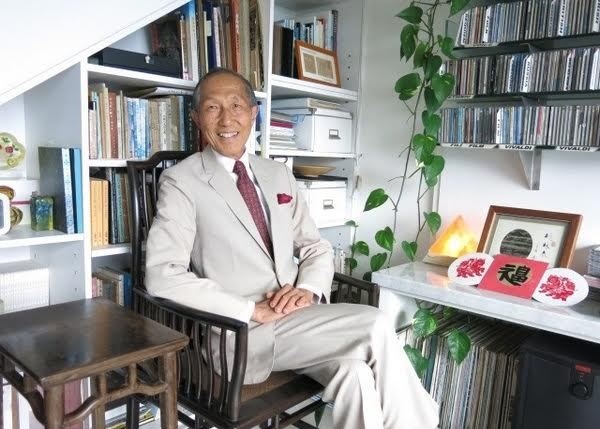
攝影: Mr. J 2016.7.15